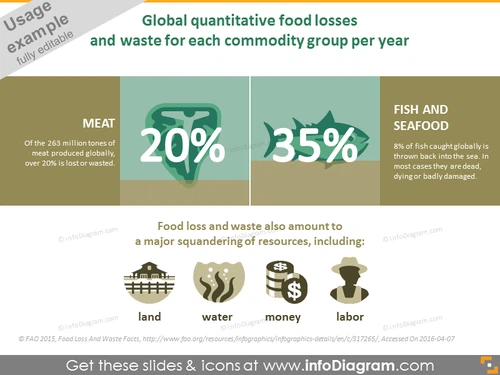Global quantitative food losses and waste per year
from deck
Food and Agriculture icons - Animal husbandry, Fishery (PPT flat clipart)
- Info
- How To Edit
- Usage example
Info
Global quantitative food losses and waste for each commodity group per year
Slide Content
The slide presents information about global food losses and waste divided into two categories - MEAT and FISH AND SEAFOOD. It reveals that 20% of the 263 million tons of meat produced globally is lost or wasted. For fish and seafood, 35% is lost, mainly due to the fishes being thrown back into the sea, often dead or damaged. The slide also details the broader impact of food loss and waste on the squandering of resources like land, water, money, and labor. Each resource is explained with an icon representing land usage, water wastage, financial costs, and labor exploitation.
Graphical Look
- The slide has a light olive green title bar with white text for the title.
- Two main rectangular sections are dedicated to MEAT and FISH AND SEAFOOD, each with a different shade of green.
- Large, bold percentage figures (20% and 35%) are prominently displayed within these sections.
- A smaller section at the bottom centers on the squandering of resources, represented by four icons symbolizing land, water, money, and labor.
- Each rectangular section has smaller text describing details about the respective food losses.
- The text and icons have a shadow effect, giving a subtle 3D appearance.
- The slide employs a limited color palette with various shades of green, creating a cohesive and thematic visual experience.
The overall look of the slide is clean and professional, using color effectively to differentiate between sections. The icons are simple and informative, aiding the visual communication of the topic.
Use Cases
- In a presentation about sustainability and the environmental impact of the food industry.
- During agricultural or food production conferences to highlight areas for improvement in reducing waste.
- In educational settings to teach about global food supply chain issues.
- As part of a business proposal for companies focusing on food waste reduction technologies or services.
How To Edit
How to edit text & colors

How to expand / shorten diagram

How to Replace Icons in infoDiagram PPT


